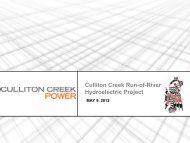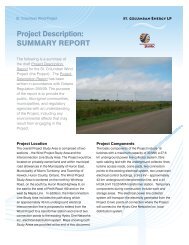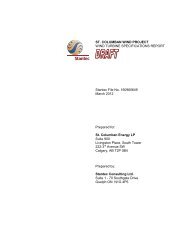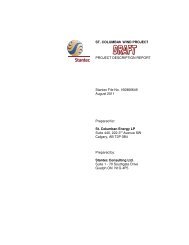Financial Report - Veresen Inc.
Financial Report - Veresen Inc.
Financial Report - Veresen Inc.
Create successful ePaper yourself
Turn your PDF publications into a flip-book with our unique Google optimized e-Paper software.
Capital Funding and Liquidity<br />
To fund our existing businesses and future growth, we rely on cash flows generated by our businesses and on the availability of debt<br />
and equity from banks and the capital markets. Conditions within these markets can change dramatically, affecting both the availability<br />
and cost of this capital. Higher capital costs directly affect our earnings and cash flows and, in turn, may affect total shareholder<br />
returns. To reduce these risks, we prepare forecasts to confirm our capital requirements and adhere to a financing strategy that<br />
supports being able to access capital on a timely and cost-effective basis. This strategy includes maintaining:<br />
• a prudent capital structure supported by investment-grade credit ratings; and<br />
• sufficient liquidity through cash balances, excess cash flow, committed revolving credit facilities, and our DRIP to meet our obligations.<br />
Through this strategy, we strive to avoid having to raise additional capital where the costs or terms of which would be regarded as being<br />
unfavourable. We have summarized recent changes to the components of our capital in the “Liquidity and Capital Resources” section of<br />
this MD&A.<br />
Foreign Currency<br />
Significant portions of our assets, net earnings and cash flows are denominated in U.S. dollars. As a result, their accounting and economic<br />
values vary with changes in the U.S./Canadian exchange rate. To date, we have not entered into any foreign currency hedges to reduce<br />
our currency risk in respect of our net U.S. dollar investment.<br />
We generally use net cash flows from our U.S. operations, supplemented where necessary with U.S. dollar borrowings, to fund our<br />
U.S. dollar capital expenditures. From time to time, we have designated U.S. dollar borrowings as a hedge against our U.S. dollar net<br />
investment in self-sustaining foreign operations. From an accounting perspective, to the extent these hedges are deemed to be<br />
effective, we record any such gains or losses in other comprehensive income.<br />
On December 31, 2012, approximately 37.2% of our net assets were denominated in U.S. dollars. For the year ended December 31,<br />
2012, we recorded an unrealized foreign exchange loss of $5.6 million in other comprehensive income on the re-translation of our U.S.<br />
net assets. At December 31, 2012, if the Canadian currency had strengthened or weakened by one cent against the U.S. dollar, with all<br />
other variables constant, total assets, net income, and distributable cash would have been $5.1 million, $0.5 million, and $1.4 million,<br />
respectively, lower or higher.<br />
Interest Rate<br />
We have financed portions of our operations with debt, including floating-rate debt. To the extent interest is not recoverable, we are<br />
exposed to fluctuations in interest rates on floating-rate debt and to potentially higher fixed rates at the time existing debt obligations<br />
need to be refinanced. To reduce this exposure, we maintain investment-grade credit ratings and generally fund long-term assets<br />
utilizing long-term, fixed-rate debt. Our floating-rate debt is primarily comprised of drawdowns under committed bank credit facilities.<br />
To reduce our exposure to interest rate fluctuations further, we may occasionally use derivative instruments, including interest rate<br />
swaps, collars and forward rate agreements, to hedge against the effect of future interest rate movements. From an accounting<br />
perspective, to the extent these hedges are deemed to be effective, we record any such gains or losses in other comprehensive income.<br />
On December 31, 2012, 22% of our consolidated long-term debt was floating-rate debt. At December 31, 2012, if interest rates applied<br />
to floating-rate debt were 100 basis points higher or lower with all other variables constant, net income before tax and distributable<br />
cash each would have been $2.7 million lower or higher.<br />
As part of York Energy Centre’s debt financing in 2010, it entered into two interest rate hedges. These hedges were entered into to<br />
manage the exposure to changes in interest rates whereby York Energy Centre receives variable interest rates and pays fixed interest<br />
rates. On April 30, 2012, one interest rate hedge was retired. Future changes in interest rates will affect the fair value of the remaining<br />
hedge, impacting the amount of unrealized gains or losses recognized in the period through equity income. For the three and 12 months<br />
ended December 31, 2012, equity income from York Energy Centre includes a $1.9 million and $0.2 million unrealized mark-to-market<br />
gain, respectively, associated with these hedges.<br />
25









